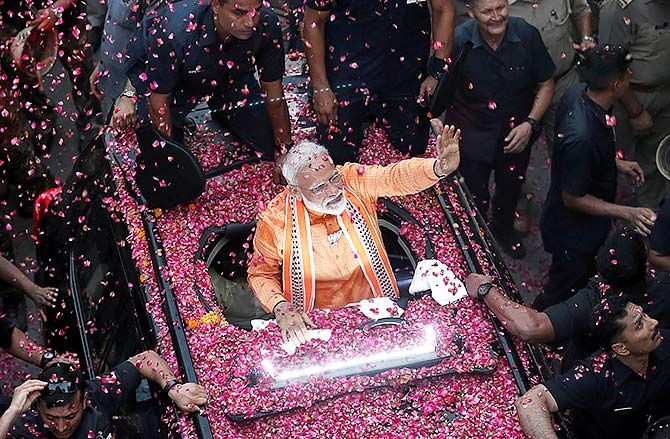 | « Back to article | Print this article |
Mihir S Sharma gives us a rundown of what could happen, depending on the number.

For months across India friends and colleagues have asked each other one question -- a question that can substitute for a greeting, for an ice-breaker, to revive conversations that have stalled.
It's a question that, in fact, doesn't even need to be spelled out in full.
It is simply: How many?
How many seats will the BJP get? Nobody knows, of course, or may even be close -- except the handful of pollsters sitting tight-lipped on exit polls from the first five phases.
But most have a likely number in mind.
More to the point, on that one number depends what the next five years will look like.
So here is a rundown of what could happen, depending on that number.
272+
Another majority for the BJP alone means it will again have swept the Hindi heartland and probably made some major dents into the rest of India.
Prime Minister Narendra Damodardas Modi's place in history will be unique.
He might have the political capital to move even faster on his agenda than he did in his first term.
Modi will continue to be unhindered by the need to consult allies or even his own party.
That said, he will know the repeat job came less from vikas talk and more from nationalism and polarisation -- which would help set that agenda.
230-272
Even if the BJP falls short of a majority by a couple of dozen seats, it will still be an undisputed victory for Modi.
He won 90 per cent of the 194 seats in the six largest states of the north and west in 2014; winning 230 to 272 would mean only a minor erosion of popularity in this area, which would still look solidly loyal to him.
But, presumably, the BJP's inroads into the south and east would not have been completely successful.
While Modi would remain undisputed in the ruling coalition, fractures within India -- between areas now solidly identified with Modi-tinged Hindutva and those that will have rejected it twice -- will continue to deepen.
210-230
The upper end of this range has long been my own answer to the "how much" question.
It's logical: it would mean that Opposition unity in Uttar Pradesh has dented the BJP's advance sufficiently for it to lose about half its seats in India's largest state, and that it has suffered a visible but not severe decline of its support across the rest of north and west India -- in keeping with its close defeats in three states towards the end of last year.
Modi's popularity will be seen as greater than that of his party, an argument he will use to try and remain firmly in command.
Allies will line up, aside from those already in the NDA: Most likely to join are the TRS in Telangana and perhaps Naveen Patnaik in Odisha and the YSR Congress in Andhra.
But if Modi stays as PM, he will have less scope to manoeuvre.
The allies will want to demonstrate to their voters that they are at least near-equal partners in governance.
The PMO's centralisation of power within the Union government will have to be diluted.
190-210
More dicey territory.
If the BJP just passes 200 or dips below it, Modi will find it hard to claim a resounding victory. The BJP and Congress fought head-to-head in about 200 constituencies in 2014; about 200 for the BJP in 2019 would mean that the Congress will have done much better than its 10 per cent strike-rate last time.
In 2014, Modi won a majority on the back of decimating the Congress in head-to-head fights and on his spectacular sweep of both Bihar and UP.
A total of 200 means neither of those has been repeated.
However, given deep pockets and the BJP's still-commanding numbers -- Modi may remain prime minister if he wishes.
But a much broader alliance would be needed, probably including at least one component of the UP mahagathbandan, probably the Bahujan Samaj Party.
This would be difficult to manage and organise, and Modi himself would have to credibly commit to reducing some of his power in office.
170-190
If the BJP falls significantly below the 200 mark -- which I think is unlikely -- it can still claim power, but in a genuine, Vajpayee-style coalition.
In this case I suspect the allies will demand Modi be replaced as PM.
Will he allow this? Or would he prefer to stay on the Opposition benches with these numbers? Nobody can predict his mind.
But the Congress probably believes that if he takes power the coalition will be fractious enough that there will be another election in a couple of years, with Modi's image of strength significantly dented.
Below 170
Some believe this previously unthinkable result is possible.
If so, then it would be an unmistakable defeat for the NDA generally, with the UPA likely rivalling its numbers or exceeding them.
The question is: What now? Can the UPA, with say 160 on its own, put together a government? Perhaps not.
In which case, we might be in a Third Front world.
But who will support it from outside -- Modi or Rahul Gandhi?
My bet would be on Modi pulling a Rajiv -- both supporting and destabilising such a government, in the expectation that another election would throw up a vote for stability and he would romp back to power.